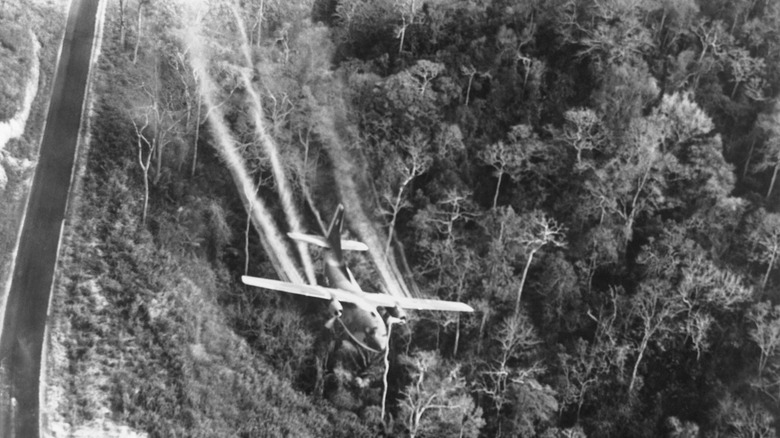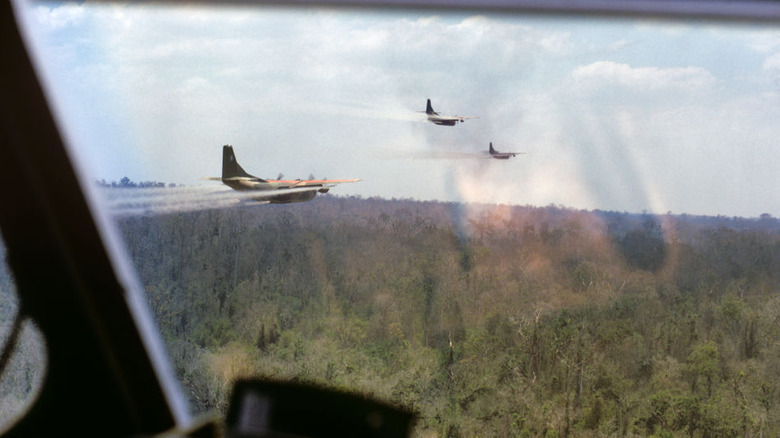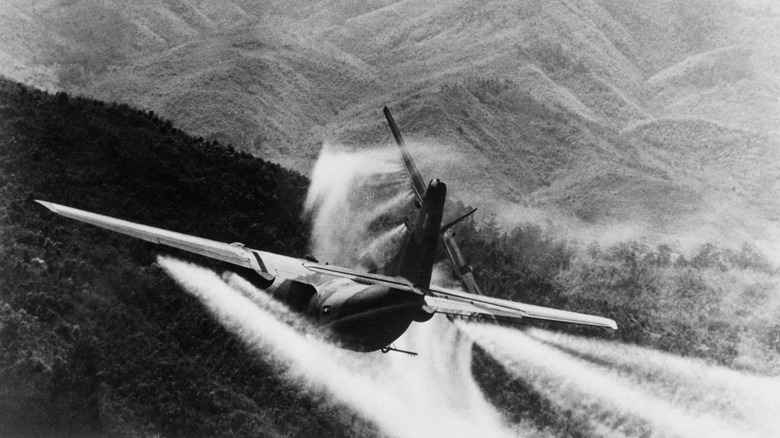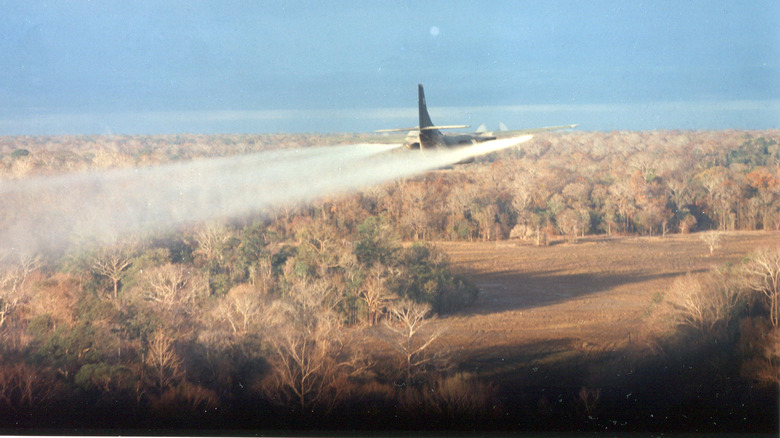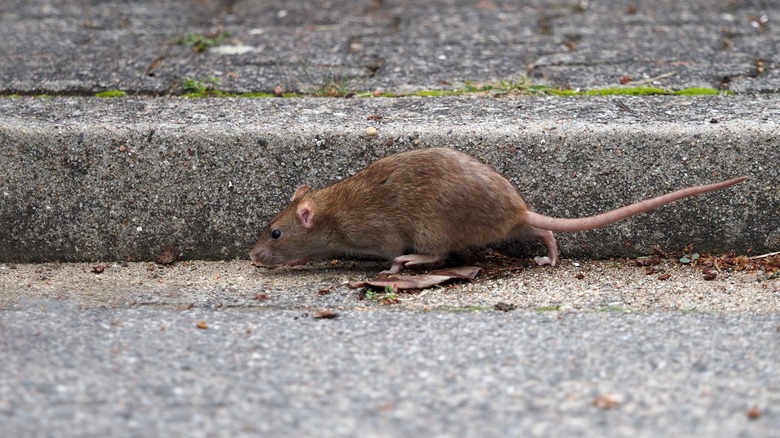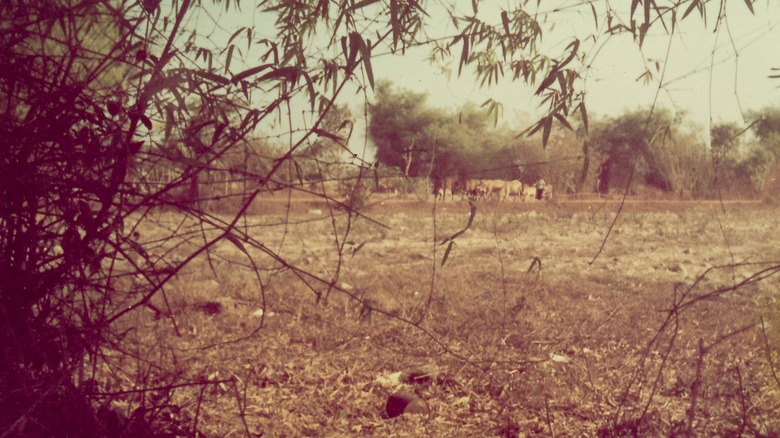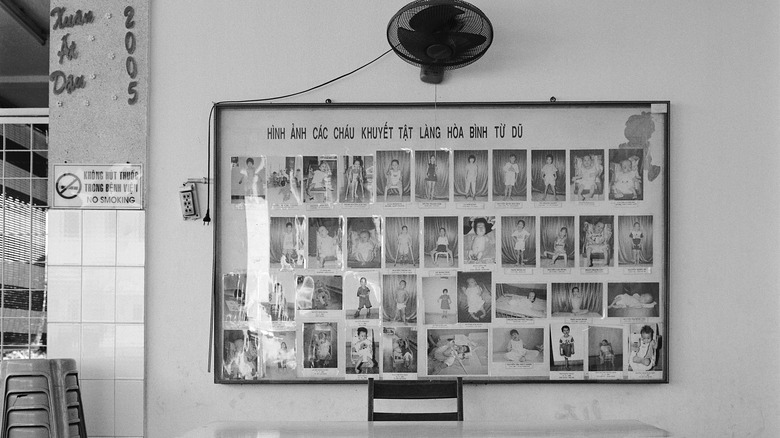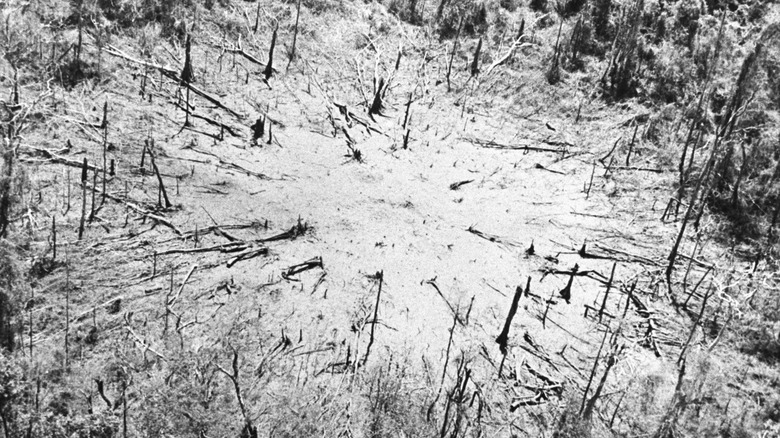The Devastating Effects Of The Vietnam War's Operation Ranch Hand
The Vietnam War is known for its many tragedies. But one of the devastations that is sometimes overlooked is the herbicidal warfare by the U.S. Air Force. Not only was this incredibly destructive at the time, but its effects continue to plague the people and the land of Vietnam.
At the time, it was pretty clear that environmental destruction was a war crime. But the four original Geneva Conventions didn't specifically mention the environment and the United States insisted that it wasn't chemical warfare, even though it was. But this legacy of chemical warfare has left its mark both on the people of Vietnam and the American soldiers that sprayed the chemicals.
Although it's been more than half a century since the herbicide campaign, its devastation continues to be felt. And considering how deep into the ecosystem some of these chemicals have sunk, some of the damage may be irreparable. These are the devastating effects of the Vietnam War's Operation Ranch Hand.
What was Operation Ranch Hand?
During the Vietnam War, the United States military sprayed millions of gallons of herbicides in Vietnam in a military operation known as Operation Ranch Hand, which lasted from 1962 to 1971. Part of a larger herbicidal program known as Operation Trail Dust, over 20 million gallons of Rainbow herbicides, including Agent Orange and Agent White, were sprayed over Vietnam, as well as Cambodia and Laos, in an effort to destroy the food supply and forest cover of Viet Cong fighters. The use of herbicide as a method of warfare by the U.S. Air Force was inspired by the actions of the British in the Malayan Emergency, during which they sprayed and destroyed any and all crops in an attempt to starve the Malayan National Liberation Army's guerilla fighters.
According to Veterans and Agent Orange, it's estimated that 10% of South Vietnam has been sprayed at least once, and 34% of the sprayed area has been sprayed more than once, adding up to over 5.5 million acres of forest and crops that were affected or destroyed. Use of the herbicides peaked between 1966 and 1969, when 80% of the herbicides in Operation Ranch Hand were sprayed.
Playing on the Smokey Bear slogan "Only You Can Prevent Forest Fires," Operation Ranch Hand operated with the motto "Only You Can Prevent a Forest."
Deforestation
Operation Ranch Hand took its motto of preventing forests seriously. Multiple sprays destroyed millions of trees as they lost their top and lower foliage. And just a single spraying of Agent Orange can kill a mangrove forest. As a result, almost 90,000 acres of mangrove forests, like the forests of Ma Da and A Luoi, were damaged or destroyed, per Agent Orange.
The Mekong Delta stream banks are also among the mangrove forests that were sprayed during Operation Ranch Hand. And not only have local woodcutters suffered from the deforestation as their source of income has disappeared, according to the Open Journal of Soil Science, the deforestation at the Mekong Delta stream banks has caused soil erosion.
By 1975, the mangrove forests were devastated. "Most of the remaining trees were only one to two meters tall or there was only bare land," according to Associate Professor Vien Ngoc Nam of Nong Lam University, per Earth Journalism Network. And few of the regions of mangrove forests have recovered. Although the Vietnamese government began reforesting the mangroves after the war, there wasn't much variety in the reforestation. In the Can Gio reserve, 97% of the mangroves are the same species.
American grass
After the wave of herbicides wiped out many of the forests in Vietnam, the land ended up being overtaken by thick green grass, which the people of Vietnam refer to as "American grass." This quick-growing grass, also known as Pennisetum polystachyum, has completely replaced much of the vast forests of over 1,000 different tree species that were sprayed with chemicals. And according to Research & Reviews: Journal of Ecology and Environmental Sciences, because domesticated animals won't graze on the American grass, it's considered to be basically a worthless weed. And the grass won't let any tree species grow.
CERES writes that in addition to the grass smothering other vegetation, the fires that run through during dry seasons make it incredibly difficult to re-introduce indigenous vegetation. It wouldn't be until 1981 that the reintroduction of indigenous vegetation was successful in places like the Ma Da Forest. But this was an incredibly arduous process, which required removing the American grass and planting fast-growing trees that can create a canopy for the indigenous vegetation to be planted underneath.
American grass isn't the only plant that has overtaken what was once acres of jungle. Bamboo has also sprouted in areas ravaged by Operation Ranch Hand.
Irreparable damage to ecosystem
With over 26,000 different species, the jungles of Vietnam contain a varied and intricate ecosystem. But the herbicidal spraying during Operation Ranch Hand irreparably changed this ecosystem. Many animals have fled their natural habitats into the forests of Laos, and countless species of flora were forced into extinction.
The Agent Orange that was sprayed onto the area can remain in the soil for decades, and it also gets absorbed by animals which are then eaten by humans. Traces of Agent Orange continue to be found in the soils of drainage canals. Although the Vietnamese government rules 150 parts per trillion as being an acceptable level to be found, in some areas the concentration of Agent Orange in the sediments is 3,370 parts per trillion. This contaminated sediment is eaten by fish and shrimp, which are then consumed by humans. As a result, contamination from Agent Orange continues to occur. But Yale Environment 360 writes that, in 2019, American and Vietnamese officials started a decontamination project on enough soil and sediments to fill 200 Olympic-size swimming pools.
Spreading the bubonic plague
As the forests disappeared because of Operation Ranch Hand, many animals were forced to flee as their homes were destroyed as well. This was the case for large animals such as elephants and tigers, as well as smaller mammals and birds. As these animals fled, the rats they once ate suddenly didn't have as many predators to face. And CERES writes that as the rat population rose, they thrived in the grasslands and were soon going after crops as well.
The increased rat population also had another effect. It allowed for the bubonic plague, as well as the pneumonic plague, to spread into the human population more easily as the rats carried fleas infected with Yersinia pestis, the bacterium that causes plague. The New York Times reports that between 1965 and 1974, there were at least 5,000 cases every year.
According to the "Encyclopedia of Plague and Pestilence," the incidence of plague in Vietnam started to drop just as American troops started leaving the country, but it's believed that by 1974, there had been up to 250,000 cases of plague.
Effect on food supplies
The jungles and forests of Vietnam weren't the only vegetation that was affected by the herbicidal campaign. Agriculture fields were also decimated, affecting the food supply of the region. In Vietnam alone, over 900 square miles of farmland was ruined, destroying over 300,000 tons of food as a result. Farmland in Laos was also destroyed by Operation Ranch Hand to a smaller extent. And although the United States claimed they were mainly trying to destroy the food supplies of Viet Cong fighters, they blanketed agricultural fields with herbicides and didn't distinguish between whose food they were destroying.
According to "Operation Ranch Hand" by William A. Buckingham, in 1965 alone, the amount of food that was ruined by the herbicides could have fed almost 250,000 people throughout the year. And it wasn't just the food supply. These were crops and land that farmers had been tending to for years. "The farmers love their land, and the things they grow. All their lives, they did not own anything better than their own little plot of land, and the few trees. The spraying in one day killed the trees that had been planted 15 or 20 years before," one Viet Cong fighter recalled. Rubber tree plantations were also affected, with roughly 30% of the rubber trees dying from the herbicides.
Some people tried to stay in their villages despite all the bombs and mortars. But once herbicides ruined the crops, many felt they could no longer stay and became refugees from Agent Orange.
Health effects
The health consequences of spraying millions of gallons of herbicides across Vietnam have been devastating to the people of Vietnam, as exposure to herbicides has been associated with a number of health problems ranging from cancers to skin conditions. It's estimated that more than 4 million Vietnamese people were exposed and that up to 400,000 Vietnamese people died as a direct result of the herbicidal campaign. Environmental Science & Technology writes that Agent Orange contamination can still be found in people's bodies more than 50 years later, like in breast milk and serum. And in a 1999 study comparing the blood of residents of Hanoi with the blood of residents of Bien Hoa, which was located near the base of Operation Ranch Hand, it was found that levels of dioxin — a key component of Agent Orange — for the residents of Bien Hoa were 135 times than those of Hanoi, according to Journal of Occupational and Environmental Medicine.
The devastation also spans across generations. At least 150,000 people in Vietnam have been born with severe birth defects linked to Operation Ranch Hand. Spontaneous abortions are also common among people who were exposed to herbicides during the campaign.
The United States Department of Veterans Affairs also acknowledges the various cancers and illnesses that can be caused by Agent Orange exposure among veterans of the Vietnam War. But although the United States offers some compensation to American veterans, the government denies any claim that the herbicide negatively affected the people of Vietnam and disputes their findings.
Environmental refugees
Although most people think of Vietnam War refugees as people who fled the country of Vietnam during the war, the herbicidal campaign led to thousands of refugees who were forced to leave their rural homes and were resettled into cities. According to The Effects of Herbicides in South Vietnam by the National Academy of Sciences, out of 18 areas that were studied, every single area showed displacement after a chemical spray. This resulted in the drastic urbanization of South Vietnam. Some rural villagers like those in A Luoi ended up moving to valleys, which limited the Vietnamese people's ability to utilize their traditional agricultural techniques, writes The Funambulist.
Ultimately, even Vietnamese refugees who were held at Florida's Eglin Air Force Base as they were relocating to the United States were likely exposed to herbicides that had previously been tested there. According to Catalyst, "The proximity and short duration since initial spraying suggests that exposure was probable given that trace exposures are still being measured in the soil and groundwater four decades after the war in Vietnam."
